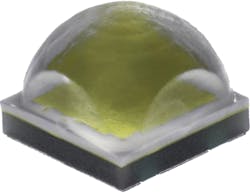Cree adds SC5-based 3.45x3.45-mm packaged LEDs in high-density and -intensity versions (UPDATED)
SSL developers can leverage the higher flux output of the SC5 technology platform with flat or domed primary optics for different applications, and in a 3.45x3.45-mm package for the first time.
Cree has announced the XHP35 family of packaged LEDs that will include products in both High Density (HD) versions with a domed primary optic and High Intensity (HI) versions with a flat primary optic. The new products mark the introduction of what Cree calls the SC5 (silicon carbide 5) technology platform being fully utilized in an LED in the 3.45×3.45-mm form factor, or what Cree calls the XP footprint based on prior packaged LEDs such as the XP-G/G2, XP-L and XP-E/E2.
The new packaged LEDs output a maximum 1833 lm from a single emitting surface, putting the LEDs in a class with multi-die LEDs in discrete packages but without the optical inefficiency of multi-die LEDs. Cree will supply the LEDs across the range of 2700K to 8300K in CCT; in 70-, 80-, and 90-CRI flavors; and in 2- or 3-step MacAdam ellipse bins.
Cree announced the SC5 platform back in late 2014 and began shipping the first XHP50 and XHP70 packaged LEDs at the beginning of 2015. The XHP prefix stands for extreme high power, and at the SC5 introduction Cree said the new platform delivered double the performance of prior LEDs relative to the same package sizes. Now that performance comes to what has been traditionally the most popular footprint for high-power LEDs.
As has been its custom, Cree will use the new LEDs and footprint legacy to allow customers to upgrade existing solid-state lighting (SSL) products with the simple change of an LED. "We’re excited that the XHP35 LED brings the performance of Cree’s Extreme High Power LEDs to the XP footprint," said Jorge Fraile, CEO of Hispaled. "In addition to delivering an impressive amount of light, the XHP35 LED allows us to leverage existing drivers to achieve the full performance of Cree’s high-power LEDs at lower drive currents."
Cree also has launched the new family in both of the aforementioned HI and HD flavors. Cree first began using the term HD to describe new discretely-packaged and chip-on-board (COB) LEDs with SC5 performance and what the company noted as better optical control factor (OCF), essentially touting the better beam control achievable with more flux from a smaller source. More recently, Cree launched the HI LEDs in the XP-L family, saying the flat optic makes the source appear smaller through a secondary optic and enabling higher center-beam candle power (CBCP).
The XHP35 packaged LEDs are immediately available in both flavors. The XHP35 HD LEDs target applications such as outdoor and high-bay lighting that requires maximum total flux. The XHP35 HI LEDs target applications such as stadium and indoor directional lighting with maximum cd on target.
"Cree continues to redefine the performance of high-power LEDs," said Dave Emerson, vice president and general manager for Cree LEDs. "The XHP35 LED represents a breakthrough that goes well beyond the incremental advances of other LED suppliers. Now, more than ever, manufacturers will be able to tap the full power of extreme high-power LEDs to forge lighting designs that were previously thought to be impossible."

Maury Wright | Editor in Chief
Maury Wright is an electronics engineer turned technology journalist, who has focused specifically on the LED & Lighting industry for the past decade. Wright first wrote for LEDs Magazine as a contractor in 2010, and took over as Editor-in-Chief in 2012. He has broad experience in technology areas ranging from microprocessors to digital media to wireless networks that he gained over 30 years in the trade press. Wright has experience running global editorial operations, such as during his tenure as worldwide editorial director of EDN Magazine, and has been instrumental in launching publication websites going back to the earliest days of the Internet. Wright has won numerous industry awards, including multiple ASBPE national awards for B2B journalism excellence, and has received finalist recognition for LEDs Magazine in the FOLIO Eddie Awards. He received a BS in electrical engineering from Auburn University.






